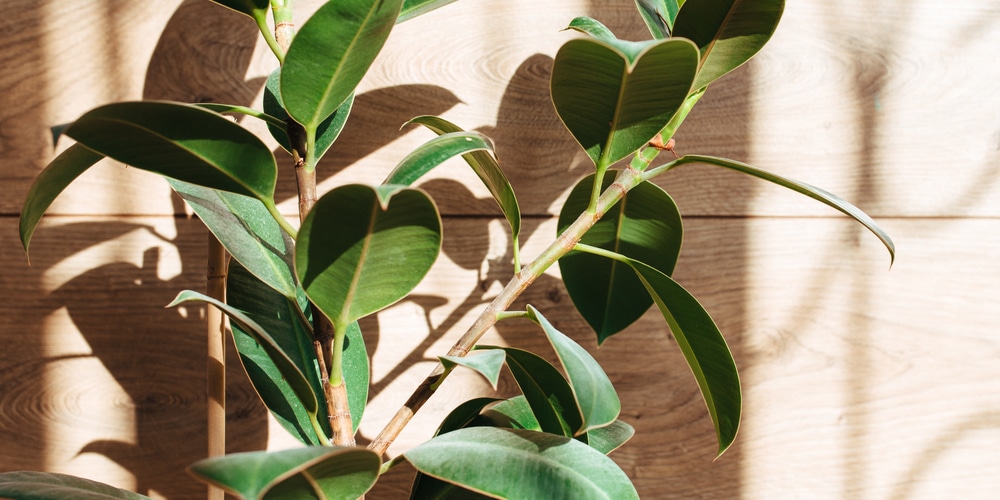The Rubber Plant is a top pick for indoor houseplants: it is easy to grow and produces stunning lush foliage that will make you recreate a little jungle in any corner of your house. These plants are fast growers. Under the proper conditions, they can grow as much as 24 inches per year. However, without adequate sunlight or care, you could end up with a leggy rubber plant.
If the lower part leaves start to fall off, you may have to deal with a bare plant. The good news is that once you know what’s causing your plant to behave in such a way, you can take measures to reverse it. If you would like to fix your leggy rubber plant, use the tips we included in this essential guide.
Characteristics
Rubber plants are part of the same family as the Fiddle Leaf Fig, without being needy. Its oval-shaped roots have bright pink central ribs that add a splash of elegant color to the plant. Interestingly, the leaves start in a coral color and get dark green as the plant ages.
One of its most striking characteristics is that new leaves only come out the top of the stalk, producing a stunning vertical growth pattern. However, if your rubber plant starts to look leggy, it will quickly look bare and unhealthy. Jump to the following section to learn what may cause this.
Leggy Rubber Plant: Causes and Solutions
Common causes of bare Rubber Plants include overfertilization, inadequate lighting, and inappropriate pruning.
Over Fertilization
As with most things in life, too much of something can be detrimental. While fertilization can support your Rubber plant’s growth, too much nitrogen in the mixture can make the plant look bulky and tall. Plus, focusing its energy on the stem, the plant won’t have enough power to produce leaves, leaving the “trunk” bare.
The same can happen with overwatering. Make sure you feel the soil before adding more water. While these plants like moisture, soggy soil will cause the roots to rot and halt growth. You should water your plant when the top two inches are dry.
Inadequate Lighting
A leggy plant shows slow growth and uneven structure and becomes tall and bare of leaves. Despite being sturdy plants, Rubber Plants require proper light and nutrients to grow and thrive into healthy and lush individuals.
Little sunlight can cause the plant to lean towards any source of light, resulting in an unevenly tall plant. Light is essential for photosynthesis to occur. Without it, the plant doesn’t have energies to grow leaves. The result is a tall and bare Rubber Plant. Move your plant to a different location if you suspect it’s not getting adequate sunlight. Place it close to a window, where you are sure it will get a couple of hours of indirect light. To prevent sunburn, consider adding some sheer curtains.
Inadequate Pruning
These plants grow fast. To ensure they maintain an attractive shape and a size that fits your interiors, you’ll have to do some pruning at least once per year. This practice will also boost your plant’s growth: by removing weak branches and leaves, you’ll make space for new ones to come out.
However, you should only prune your plant during the summer, during its growth period. If you do that in the winter, when the plant is dormant, you might cause some shock to your rubber plant. Without the necessary energy, the plant will struggle to fill in the bare spaces, which will make it look leggy.
How To Fix A Leggy Rubber Plant?
Your message has been sent
For starters, ensure you prevent leggings by adding an adequate dosage of fertilizers, placing them in a spot with plenty of indirect light, and pruning stems at the right time without overdoing it.
You may have to rotate your plant every month or so to allow it to receive sunlight e evenly and grow vertically without any problem. If you are afraid it won’t get enough sun during the winter, consider getting an artificial grow light. You can find it online or at your favorite gardening store.
Also, before adding fertilizer, make sure you check the recommended dosage. Stop adding products during the winter and fall and feed your plant once a month during the spring and summer. Avoid fertilizers rich in nitrogen or choose an organic product.
